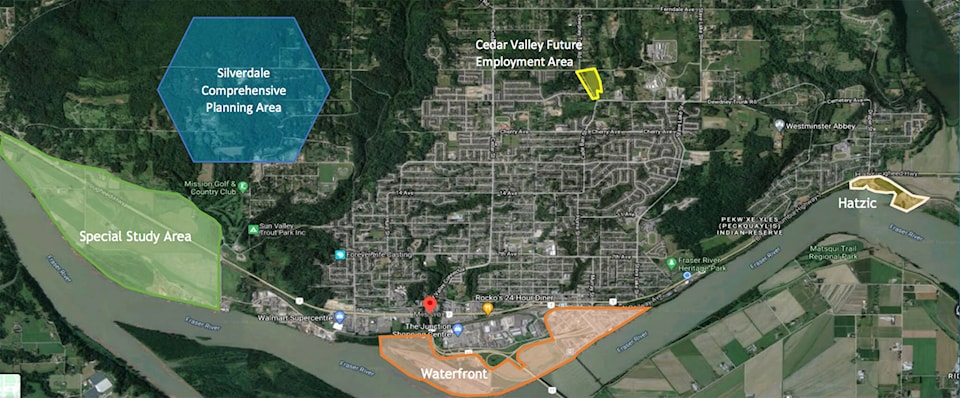Mission homeowners, facing the burden of the city’s heavy dependence on property tax, often point to the same problem: the lack of employment lands.
A set of four detailed recommendations on how to unlock local jobs were provided by a council-appointed committee on June 8, providing insight into how the city might shift away from the current reliance on a 75 per cent residential tax base.
The number one solution would be to attract institutional employment to the city, according to the Economic Development Select Committee (EDSC).
“We’re urging you to focus on selling Mission as a place for institutional expansion,” said EDSC’s former chair, Jack Davidson.
Since 2019, the EDSC has been helping with data gathering, industry analysis and labour market forecasting to update the city’s 2010 Employment Lands Strategy (ELS).
Coun. Cal Crawford called their report the most important and powerful document the council has dealt with in their term.
“Every citizen I’ve ever talked to … has the impression that we’re out of whack on our tax base – and in fact, we are,” Crawford said. “When we took this on as a strategic goal … This is exactly what I was hoping for.”
Council unanimously voted to adopt the new recommendations into a draft of the new ELS, which has not yet come before council.
Current employment woes
The issues highlighted in the ELS are many.
Designated commercial and industrial zoning account for only a sliver of the city’s total land supply in the OCP, and existing businesses may be displaced by things like waterfront development.
Mission is expected to grow by approximately 50 per cent over the next 20 years, and has an aging population – 41 per cent per cent are over 55 years old.
As of 2016 (updated numbers are coming from StatsCanada): 63 per cent of Mission’s workforce, over 20,000 people, travel outside the city for work. If one includes the trades, that number goes up to 67 per cent. Abbotsford by comparison, exports 38 per cent of its workforce; Chilliwack, only 33 per cent.
Mission is losing 1,990 retail jobs and over $250 million in retail expenditures; only 34 per cent of Mission businesses provide goods and service to the community.
The city cannot easily create new industrial subdivisions, a problem acknowledged back in the 2010 ELS.
There is a shortage of appropriate, affordable and accessible industrial land above the flood construction level; where it is located, the land is fragmented and located in rural residential areas struggling with commercial traffic.
Industrial developers frequently inquire about Mission, but usually want parcels ranging from five to 20 acres, and located close to highways and rail, according to staff.
While the ELS predicts Mission will have enough commercial land available for growth in the next 20 years, it predicts a “significant shortfall of industrial land,” even as in-stream developments come online.
Four recommendations
The city’s existing land stock is best suited for institutional jobs, according to the EDSC.
The first recommendation is to look for opportunities to attract educational, healthcare, social services, arts, entertainment and public administration institution-types to the city.
Not only is there a shortage of highly skilled professionals in the city, but attracting the institutions would provide a “significant boon” to Mission’s economic growth, making it regionally competitive.
The focus should be on health-care and senior-care type establishments, as Mission’s population ages, said Davidson.
“The jobs-per-square foot are relatively high, it’s generally clean and has a larger return on investment,” he said.
A development corporation should be created to accelerate developments that create jobs in strategically designated areas like the waterfront and downtown core, according to the second recommendation.
All significant land use decisions in the future should take into account the land’s potential for future employment purposes, the third recommendation says, complete with economic analysis.
“We want to make (it) top of mind every time you consider a land use,” Davidson said.
The final recommendation is to develop key performance indicators for every major municipal initiative to streamline awareness across municipal departments, ensuring efficiency of resources, capacity and accountability.
Even if the recommendations are adopted in the new ELS, it’s unlikely Mission will be able to shift the property tax burned in the foreseeable future, said EDSC’s current chair, Ed Sarfeld.
The city should “measure employment land success in terms of bottom line contributions to the tax base while also seeking to increase opportunities for residents to work in the community,” Sarfeld said.
Outside of the waterfront, other potential areas have also been identified in Hatzic, four industrial resource locations along Dewdney Trunk Road and Keystone Avenue, a large special study area south of the Lougheed Highway to the west of the city, and in Silverdale’s comprehensive planning area.
